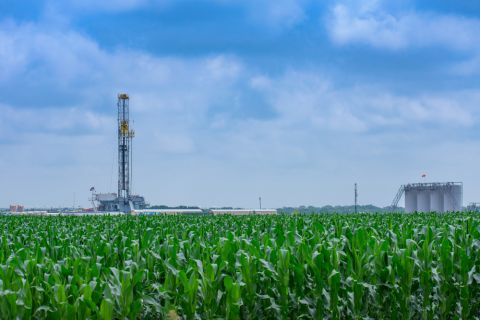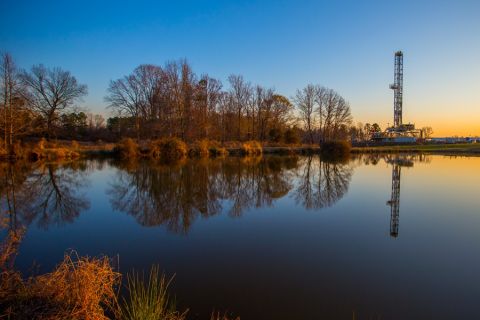 |
| Jack Lee and Jim Elison (Shell geologist) at Kanatak. (Picture courtesy of J. H. Elison) |
We first discovered Jack Lee in 1954 on our first visit to Kanatak, Alaska, which is located at the head of Portage Bay, almost 350 miles (563 km) southwest of Anchorage. We were conducting geological mapping services on the Alaska Peninsula for Shell Oil Co. from Wide Bay to Alinchak Bay, a distance of about 75 miles (121 km).
It was near our first campsite about 3 miles (4.8 km) from the largely abandoned village of Kanatak. Out of one of the crumbling structures came this half-blind, stumbling 86-year-old man just delighted to see us. Jack had lost one eye 30 years earlier in a fight, and his remaining eye wasn’t too good. Kanatak villagers called him One-Eyed Jack. He made a home brew that he called beer, but to us it looked like Katmai ash suspended in a fluid that must have been 10% alcohol and always included some drowned mosquitoes.
One day the wrangler whom we were to meet in Kanatak with our horses did not show, and we were worried that in trying to find us that the 12-ft (3.6-m) incoming tide had caught him against the rocks. Upon seeing our distress, Jack led us to a very sick wrangler hidden in one of the abandoned structures. Our man had drunk three bottles of Jack’s powerful brew, an episode he never repeated.
Meet Jack Lee
Jack Lee was born in Canada in 1869 and died in 1963 in Sitka, Alaska. By 1954 he was already an icon on the Alaska Peninsula. Though seemingly a person of no lasting accomplishments, he was an individualist and a skeptic worthy of remembrance if for no other reason than being inextricably associated with the catastrophic Katmai eruption in 1912.
According to the 1900 Federal Census of Alaska, Jack is noted as arriving in the territory in May of 1898 from his former home in Duluth, Iowa. At the time of the census (March 3, 1900), he was listed as a miner in the Sunrise mining district on the northern Kenai Peninsula, an area that was the locus of an early pre-Klondike gold rush.
Shortly after this date, he was involved in the early reconnaissance of the oil seeps west of Puale Bay being grubstaked by Austin E. (Cap) Lathrop, Alaska’s equivalent of Andrew Carnegie. Jack’s finding and characterization of the oil seeps along Oil Creek resulted in the exploration and development of the early wells drilled by cable tools during 1901 to 1905, the earliest period of oil drilling (contemporaneous with those on the Iniskin Peninsula and in the Katalla District) in Alaska.
By 1930, he was listed as a trapper living in Kanatak. However, via horseback, his observation of the impressive live oil seeps in the Ugashik and Becharof Lakes area and his subsequent involvement in the early drilling entirely consumed his future interests.
More importantly, Jack remains a provocative reminder of Alaska’s pre-1958 drilling and was quite possibly the earliest observer (excepting natives and possibly Russians) of the oil seeps in the area now encompassed by the Becharof National Wildlife Refuge.
In 1922 the Lee #1, the earliest deep test and named after Jack, reached a total depth of 5,043 ft (1,538 m) and was followed by the 7,596-ft (2,317-m) Tidewater Grammar, which came up as a dry hole in 1940 on the Bear Creek anticline. Failure to find production in the early years doomed the village, and it was largely abandoned by 1940. Later in 1958 the most expensive onshore well drilled at that time, the Humble Bear Creek, reached a total depth of 14,374 ft (4,382 m). When it too came up a dry hole, it added another nail in Kanatak’s coffin.
In our first field season we were mapping the Bear Creek anticline in detail using horses for transportation. The Bear Creek Anticline not only had major-sized domal closure, but it also had active oil seeps on the crest and should have been a major discovery except that there were no reservoir beds with any porosity.
The Upper Triassic biostromal limestone that locally forms the base of the Kamishak Formation at Puale Bay and considered the prime objective was not recognized in the Bear Creek well. And, at the time, with plenty of company, I felt that much of the peninsula was no longer an area of interest. In the summer of 1955 we mapped to Alinchak Bay, did not see Jack, and feared the worst. In the 1956 summer we mapped Wide Bay, an even bigger domal structure than the Bear Creek structure, and to our relief discovered Jack had moved to a small cabin at Wide Bay, where we would occasionally drop down in our helicopter to see that he was okay. Mt. Lee, one of the higher peaks in the Wide Bay area, was named for Jack.
Jack was indomitable, living by himself with brown bears, crabby moose, and wolverines as neighbors. But when fall arrived he would return to Kodiak. That season in 1956 was the last we saw or heard of Jack. He died in 1963 in Sitka where by our figures he would have been about 95.
Jack Lee’s significance
Skeptical but optimistic,?Jack Lee continued?to doubt that exploration drilling had adequately evaluated his domain and would have appreciated the updated concepts formulated by a fresh look in recent publications by Robert B. Blodgett and Bryan Sralla and others for their fresh approach fueled by a critical look at accepted clichés — clichés that had caused this part of the Alaska Peninsula and, to some degree, the North Aleutian Basin to have been written off by major companies until recently.?Jack was an individualist who would neither understand nor care about the actual details only that the search has new vigor and has been renewed in other areas of the Peninsula and in the North Aleutian Basin.
Jack was a skeptic, and skepticism is a phenomenon that can upset accepted geologic dogma, often proven wrong anyway (i.e., from a professor at the University of California, “I’ll drink every drop of oil produced at Coalinga” and from a well-known corporate-level geologist, “They’ll never build a pipeline from Prudhoe Bay”).
Individualism and skepticism are powerful tools when forced to reconsider alternatives to readily accepted interpretations of modern exploration results. Computer imaging provides a good illustration. Graphic models, automatically considered gospel by many geoscientists, may be interpreted through their own bias. At its worst, this could include a seismic data analysis that is keyed to corporate planning.
Thus to me, Jack was notable and deserving of recognition. His individualism and sometimes annoying, but thought-provoking skepticism remains useful in any field where clichés provide safe guards from new concepts. I like the last line in Mr. Eicher’s 1944 article quoting Jack Lee, “There’s oil in these hills, and they’ll be back someday to get it. You can bank on that.”
Editor’s Note: A longer version of this article first appeared in Alaska Geology: Newsletter for the Alaska Geological Society Inc., Volume 38, Number 9, May 2008. The primary author, Herb Mann, has worked as a geologist in the oil and gas industry for 58 years. Specific details on the several rises and declines of Kanatak and commentary on Jack Lee were found by his coauthor in a 1944 issue of “Alaska Life: the Territorial Magazine” in an article by George Eicher Jr.
Recommended Reading
Enverus: 1Q Upstream Deals Hit $51B, but Consolidation is Slowing
2024-04-23 - Oil and gas dealmaking continued at a high clip in the first quarter, especially in the Permian Basin. But a thinning list of potential takeout targets, and an invigorated Federal Trade Commission, are chilling the red-hot M&A market.
EIA: Permian, Bakken Associated Gas Growth Pressures NatGas Producers
2024-04-18 - Near-record associated gas volumes from U.S. oil basins continue to put pressure on dry gas producers, which are curtailing output and cutting rigs.
SilverBow Saga: Investor Urges E&P to Take Kimmeridge Deal
2024-03-21 - Kimmeridge’s proposal to combine Eagle Ford players Kimmeridge Texas Gas (KTG) and SilverBow Resources is gaining support from another large investor.
Mesa III Reloads in Haynesville with Mineral, Royalty Acquisition
2024-04-03 - After Mesa II sold its Haynesville Shale portfolio to Franco-Nevada for $125 million late last year, Mesa Royalties III is jumping back into Louisiana and East Texas, as well as the Permian Basin.
‘Monster’ Gas: Aethon’s 16,000-foot Dive in Haynesville West
2024-04-09 - Aethon Energy’s COO described challenges in the far western Haynesville stepout, while other operators opened their books on the latest in the legacy Haynesville at Hart Energy’s DUG GAS+ Conference and Expo in Shreveport, Louisiana.





